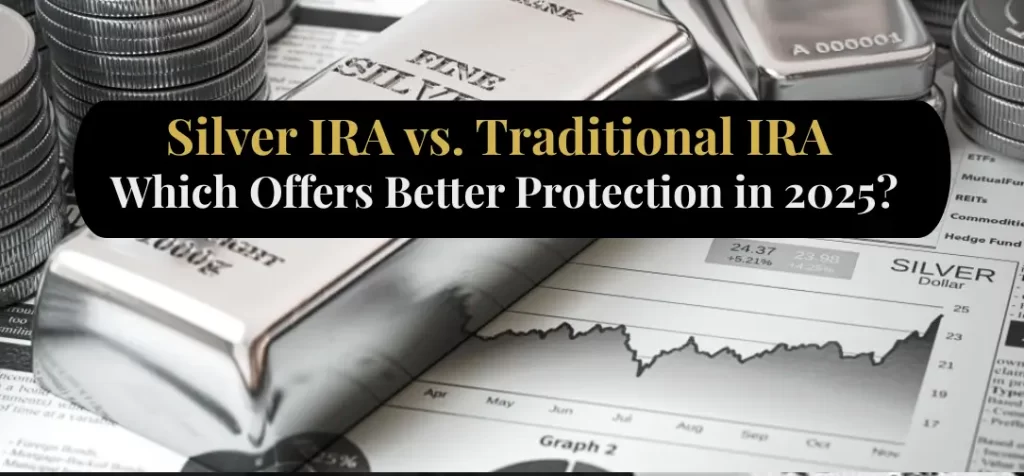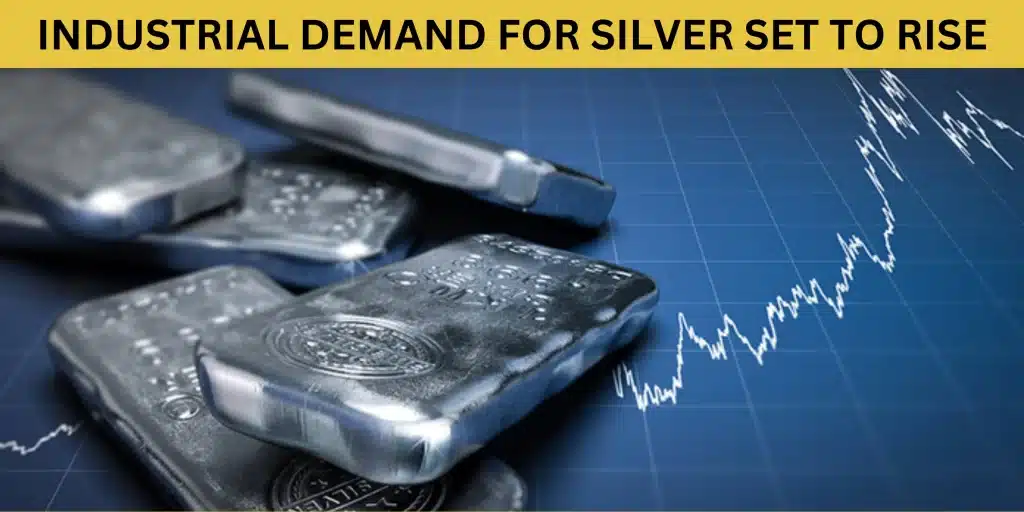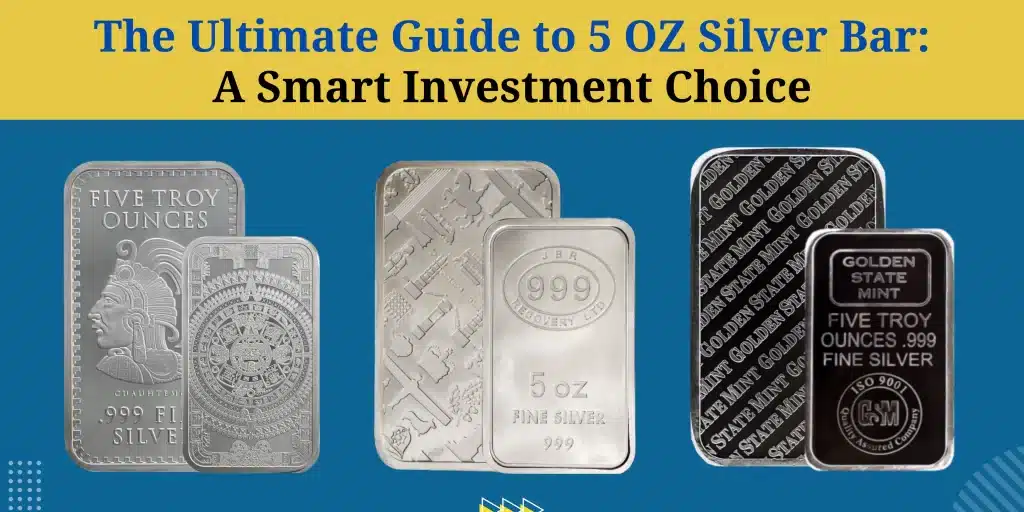Silver IRA vs. Traditional IRA: Which Offers Better Protection in 2025?
When it comes to safeguarding your retirement portfolio, choosing the right Individual Retirement Account (IRA) can be a game-changer. As the global economy faces inflation concerns, market volatility, and geopolitical uncertainty, many investors are asking: Is a Silver IRA better than a Traditional IRA in 2025?
In this blog, we’ll dive deep into both options and help you determine which offers better protection for your financial future.

What is a Traditional IRA?
A Traditional IRA is a retirement account that allows you to invest in stocks, bonds, mutual funds, and other paper assets. Contributions may be tax-deductible, and your investment grows tax-deferred until retirement.
Key Benefits:
- Tax-deductible contributions (depending on income)
- Tax-deferred growth
- Widely accessible through most financial institutions
However, a major drawback of Traditional IRAs is their exposure to stock market risk. In times of recession or market downturns, your investments can shrink significantly.
What is a Silver IRA?
A Silver IRA is a type of Self-Directed IRA (SDIRA) that allows you to invest in physical silver, including silver bars and coins, instead of traditional paper assets. These accounts are often grouped under the term Precious Metals IRAs, which can also include gold, platinum, and palladium.
Eligible investments include:
- Silver coins (e.g., American Silver Eagles, Canadian Maple Leafs)
- Silver bars (e.g., 1 OZ, 10 OZ, 100 OZ bars from approved mints)
- Other IRA-approved silver bullion
Precious Metals in 2025: Why Investors Are Turning to Silver
In 2025, the shift toward tangible assets like precious metals continues to gain momentum. Silver, in particular, is appealing for several reasons:
- Hedge Against Inflation: Silver historically retains its value during inflationary periods.
- Physical Ownership: You hold real assets—not paper promises.
- Industrial Demand: Silver is used in solar panels, electronics, and EVs, driving long-term demand.
- Diversification: It provides a safe haven outside the traditional stock market.
Why Silver is a Smart Investment in 2025
Silver is not just a store of value—it’s an industrial metal in high demand. Here’s why investors and collectors are bullish on silver in 2025:
- Inflation Hedge: Silver holds purchasing power when fiat currencies fall.
- Physical Asset: Unlike stocks, it cannot go bankrupt.
- Industrial Demand: Used in solar panels, EVs, electronics, and more.
- Affordability: Compared to gold, silver offers a lower entry point.
Adding precious metals like silver to your retirement account is a proven strategy to weather economic storms.
Which IRA Offers Better Protection Against Inflation and Risk?
In terms of long-term security and portfolio protection, Silver IRAs often outperform traditional IRAs.
- Inflation Protection: Silver historically increases in value during inflation.
- Market Independence: Physical silver is less tied to market swings.
- Global Uncertainty: Silver performs well during economic and geopolitical instability.
For investors seeking real asset protection, Silver IRAs offer a clear advantage.
Comparing Silver IRA and Traditional IRA in 2025
| Feature | Silver IRA | Traditional IRA |
| Assets | Physical silver bars and coins | Stocks, bonds, mutual funds |
| Inflation Hedge | Strong protection through tangible silver | Limited, depends on market performance |
| Market Risk | Less exposure to stock volatility | High exposure to market fluctuations |
| Tax Advantages | Same tax-deferred or tax-free growth (Roth) | Tax-deferred or tax-free growth |
| Storage Requirements | Requires IRS-approved depository | No physical storage needed |
| Liquidity | May take time to sell silver | Easier to liquidate stocks or bonds |
| Diversification | Strong for alternative asset exposure | Limited to paper-based assets |
The Safety Factor: Which Offers Better Protection?
When assessing financial protection, particularly in uncertain times, Silver IRAs often come out ahead due to their stability and intrinsic value.
1. Protection from Market Crashes
Traditional IRAs heavily rely on market performance. In contrast, silver retains value during crises, giving you peace of mind.
2. Inflation Defense
As the dollar loses purchasing power, physical assets like silver historically rise in value—making a Silver IRA a strong inflation hedge.
3. Global Uncertainty
With ongoing geopolitical tensions, many investors are shifting to precious metals as a safe-haven investment. Silver, being more affordable than gold, becomes a practical choice for long-term stability.
What Are the Drawbacks of a Silver IRA?
While Silver IRAs offer many benefits, they’re not without trade-offs:
- Storage Fees: You must store your silver in an IRS-approved depository, which can come with annual costs.
- Limited Liquidity: Selling physical silver can take longer than liquidating traditional investments.
- Custodian Requirements: Not all financial institutions offer self-directed IRAs, so you’ll need a specialized custodian.
However, many investors feel that the added security of holding physical assets outweighs these drawbacks—especially in today’s uncertain economy.
Should You Combine Both?
Here’s a smart tip: Diversification is key.
Many savvy investors hold both a Traditional IRA and a Precious Metals IRA to balance growth potential and asset protection.
- Use the Traditional IRA for potential long-term gains in the stock market.
- Use the Silver IRA as a hedge against inflation and economic turbulence.
This blended approach provides both growth and security—a win-win for 2025 and beyond.
How to Start a Silver IRA
Starting a Silver IRA is easier than you might think. Here’s a quick step-by-step guide:
- Choose a reputable custodian who specializes in Precious Metals IRAs.
- Open a Self-Directed IRA and fund it (via rollover or new contribution).
- Select IRA-approved silver bars and coins to add to your account.
- Your metals are safely stored in an IRS-approved depository on your behalf.
Pro Tip: Work with a provider that offers transparency, competitive pricing, and expert guidance—like Gibraltar Group.
Final Verdict: Silver IRA or Traditional IRA?
In 2025, the answer depends on your financial goals and risk tolerance:
- Choose a Traditional IRA if you’re comfortable with market risk and want higher growth potential.
- Choose a Silver IRA if you’re seeking long-term protection, inflation defense, and tangible assets.
Or better yet—combine both to get the best of both worlds.
Why Choose Gibraltar Group for Your Precious Metals IRA?
At Gibraltar Group, we help you navigate your retirement options with confidence. Whether you’re looking to add gold and silver bars, invest in IRA-approved coins, or start a full Silver IRA, we offer:
✅ Trusted expertise
✅ Competitive prices
✅ 100% authentic precious metals
✅ Seamless IRA rollover support
Protect your retirement with real value. Invest in silver today.
FAQs
Q1: What is a Silver IRA?
A Silver IRA is a type of retirement account that allows you to invest in physical silver bars and coins, offering protection against inflation and market risks.
Q2: What are the benefits of a Silver IRA over a Traditional IRA?
A Silver IRA provides protection against inflation, market volatility, and currency devaluation by holding tangible assets like silver. Traditional IRAs are more vulnerable to market swings.
Q3: Can I hold physical silver in a Silver IRA?
Yes, you can hold physical silver bars and coins in a Silver IRA, as long as they meet IRS standards for purity and are stored in an approved depository.
Q4: How do I open a Silver IRA?
Opening a Silver IRA involves finding a reputable custodian, funding the account, selecting IRA-approved silver, and storing it in a secure, IRS-approved depository.
Q5: Are Silver IRAs a good investment in 2025?
Yes, Silver IRAs are considered a smart investment in 2025 due to silver’s historical ability to act as a hedge against inflation and its increasing industrial demand.




